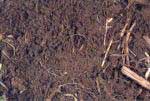 |
Potassium, phosphorus and sulphur
Summary
We investigated the effect of four different organic farming systems (two livestock densities in combination with two types of organic manure) on crop yields, K leaching and K balances in a six course crop rotation. Average K concentrations in soil water extracted by means of ceramic suction cups at 1 m depth were 0.6 mg K/l, corresponding to a K leaching loss of 1.5 kg/ha/yr which was less than expected from values re-ported in the literature. Variation in K budgets from –12 to +30 kg/ha/yr did not affect K leaching. In an addi-tional experiment with application of 988 kg K/ha as KCl, K leaching acounted for only 0.2% of the applied K although 40% of the accompanying Cl was leached. The main part of the applied K was retained in the top-soil. It was concluded that K leaching was a result of the fertilizer history rather than of the current K budget.
The potato trials have shown that the addition of potassium to slurry manure increases yield. Both potassium and sulphur improve tuber quality.
Sulphate leaching and sulphur (S) balances were investigated in an organic cereal crop rotation at three sites during the first three years after conversion to organic farming. Sulphate leaching decreased signifi-cantly during the three years. The S-balance indicated that no substantial S-deficit may be expected in the longer term provided excess S is maintained in the system and the availability is synchronised with plant needs. On sandy soils it may in the longer term be necessary to apply S in a plant-available form. Sulphate leaching and S balances was investigated also in a dairy crop rotation converted to organic farming in 1987.
In order to reduce the relatively large quantity of S leached different catch crops were tested for their ability to reduce sulphate concentrations in autumn and especially the cruciferous crops had the ability to efficiently reduce the leaching potential.
The ability to barley plants to utilised a limited S-resource was investigated. The S-availability had a huge effect on the N-utilisation of plants. At sufficient S-supply ca. 70% of leaf N was remobilized during grainfill-ing, whereas only 35% was remobilized in S-deficient plants. Sulphur was more immobile in plants than N, since 50% of grain S originated from remobilization, whereas only 25% of grain S was from remobilization. The availability of S during grainfilling is relatively more important than the availability of N. S-deficiency at high N-levels caused decreasing grain quality.
The effect of S-application at different times during the growth season was investigated regarding yield, fertil-izer efficiency and plant quality. Late S application was successful even at a late stage. Although deficiency symptoms appeared already at the beginning of tillering it was possible to correct this by S application until the middle of stem elongation without yield reductions. At severe S deficiency there was an effect of S appli-cation after heading. Furthermore, S application had a relatively larger effect on grain quality than on yield and this was most pronounced at later S-application.
White clover plants were capable of maintaining a high proportion of N derived from N2 fixation even under conditions where growth is starting to decline due to P or K deficiency. The competition between white clover and ryegrass in mixed stands changes in favour of the grass when P and K availability increases. Rhizode-position provides a very substantial input of N to legume-based grassland systems with great consequences for ecosystem N balance and turnover and N transfer from clover to ryegrass is a much more dynamic and quantitatively important process than previously recognised.
The effect of soil P status on the yield and quality of a clover-grass crop was investigated using a long-term field experiment with varying soil P status. The field experiment included three treatments, ‘0P, ‘15P’ and ‘30P’. The soil P status measured as Olsen P was respectively 12, 24 and 36 mg P kg-1 soil in the three treatments, which corresponds to respectively too low, adequate and more than adequate P levels for crop growth. The clover-grass yield was also negatively affected by the P status in the 0P treatment (0P: 8.4, 15P: 10.6 and 30P: 11.1 tonnes ha-1). The yield of grass was low because the N-fertilisation of the experiment was omitted this season and it was not affected by the soil P status. In contrast, the yield of clover was gen-erally high and negatively affected by low soil P status. N and P content of both grass and clover were nega-tively affected by low soil P status. We therefore conclude, that insufficient soil P status affect not only the yield, but also the quality of the grass-clover crop. Furthermore, we conclude, that due to the low soil P status the crop invested more resources in root growth, which resulted in significantly larger root mass and root length density in the 0P treatment.
|